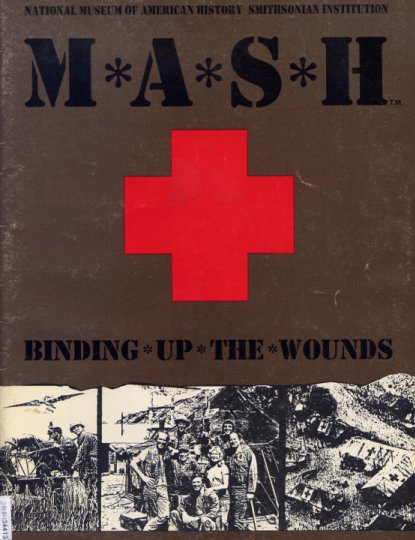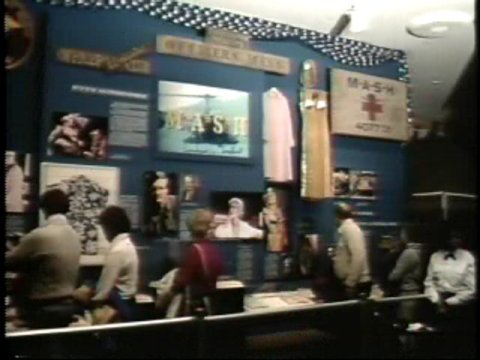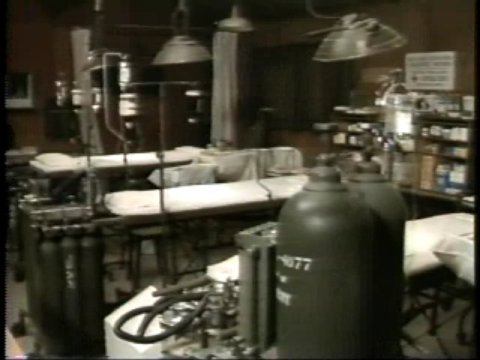Introduction
The cast and crew of M*A*S*H wrapped the last day of filming on Friday, January 14th, 1983 at exactly 6:05PM, according to The Associated Press [1]. The episode being filmed wasn’t the finale but instead the penultimate episode entitled “As Time Goes By.” Production on “Goodbye, Farewell and Amen” had already been completed. On January 4th, Donnie Radcliffe had reported in The Washington Post that “under consideration, though nothing has been signed yet, is a plan to ship portions of the sets” to the Smithsonian in Washington, D.C. for display [2].

Copyright © The National Museum of American History, 1983 [1]
On February 27th, the day before the finale aired, The Philadelphia Reporter noted that negotiations were underway to send The Swamp to the Smithsonian [3]. In another February 27th article, The Boston Globe‘s Angela Fox Dunn considered the reasons why sets from M*A*S*H deserved to be in the Smithsonian: “Because there has seldom, if ever been so much talent collected on one show, or so much insistence on quality in every single episode, every plot, every line and action” [4].
John Carmody reported in The Washington Post on March 28th that “there’s still a well-mannered wrestling match going on over which branch of the Smithsonian gets the ‘M*A*S*H’ artifacts” [5]. Ultimately, two complete sets (The Swamp and The O.R.) and hundreds of props from M*A*S*H were shipped to the National Mall in Washington, D.C. where they were incorporated into a new exhibition called “Binding Up the Wounds” at the Smithsonian Institution’s National Museum of American History (the Museum).
Signing Over The Sets
Alan Alda, Mike Farrell, William Christopher and producer Gene Reynolds helped officially unveil the exhibition. Speaking of his time on M*A*S*H, Alda said “looking at the set and the little mementos in the room, like the picture of Harry Truman, it is for me an emotional ending of that experience” [6]. Farrell noted that “what we tried to do was support the notion that people are valuable and that war is senseless. And we’re proud it’s being enshrined here at this institution” [7].
A press release about the exhibition included the following:
The show’s objects were rooted in the 1950s, but the issues, conflicts and attitudes presented in the scripts addressed national concerns prevalent during the 1970s and 80s. Using a format of dark comedy unprecedented in U.S. television, the scripts set forth various perspectives about the Vietnam War, the disclosures of Watergate, the rise of feminism and a turn from political protest and idealism to interest in individual fulfillment. [8]
Roger Piantados, writing in The Washington Post, suggested that the M*A*S*H exhibition “will make the Smithsonian Museum of American History so popular a tourist stop this summer that someone may be moved to create a TV sitcom about the place” [9]. He called it an “engrossing, entertaining and mostly level-headed exhibit, of interest as much to fans of military and medical history as of television” and noted that it would run through September 30th” [10].
A Popular Attraction
“M*A*S*H — Binding Up The Wounds” officially opened on Saturday, July 30th, 1983. Included were the two complete sets, one of the show’s 14 Emmy Awards, early drafts of the pilot script, some 30 costumes and more. In what Gene Krzyzynski of The Philadelphia Inquirer, called “an unusual pictorial essay,” also part of the exhibition was a photographic essay made up of fifteen images from the series set next to photographs from actual MASH units at work during the Korean War [11].
On August 12th, The New York Times reported that during the previous week more than 17,000 visitors had seen the exhibition, “the largest turnout ever for a single museum display” [12]. Gary Kulik, chairman of the Museum’s department of social and cultural history, explained the popularity of the exhibition by stating “there was something about the spirit of the show itself that touched a lot of people. If we did a more historically sophisticated exhibit on Korea, it would not have been as popular” [13].

Copyright © The National Museum of American History, 1983 [2]
By the afternoon of August 15th, exactly 30,391 people had visited the exhibition; according to The Christian Science Monitor, they often had to stand in line for hours to get the chance to see it [14]. John Carmody reported on September 29th that Larry Gelbart flew into Washington specifically to visit the exhibition (Carmody stated “he liked it”) [15]. The New York Times reported on October 19th that 899,000 visitors had seen “M*A*S*H — Binding Up The Wounds” and due to its incredible popularity the exhibition had been extended to January 2nd, 1984.
The long lines weren’t a problem for Museum director Roger G. Kennedy, who pointed out that “we knew that everyone would want to see ‘M*A*S*H’ and would have to wait in line, and while they are in line, they will have to think” [16]. Furthermore, “people turn from the ‘M*A*S*H’ line, the First Ladies’ gowns, and their attention is riveted to something that people had passed by for 10 years” [17].
Available as souvenirs were a special booklet, a poster, hats, t-shirts, patches and more. Also on sale were M*A*S*H toys and and even personalized dog tags.
The Exhibition
Aside from the two standing sets and the photographs comparing real MASH units to the fictional M*A*S*H, the Museum exhibition also included a display of props and costumes from the series. The Swamp and O.R. sets were shipped directly from 20th Century-Fox’s Stage 9 in Hollywood, California. According to the official M*A*S*H — Binding up the Wounds souvenir booklet, the sets were rebuilt at the Museum with the help of Bert Allen, set decorator for M*A*S*H from 1976 to 1983. Due to space limitations the Swamp set was reduced in size by two feet; the O.R. could only fit three operating tables rather than the four used during production [18].

Copyright © The National Museum of American History, 1983 [3]
In all, some 2,000 objects were donated to the National Museum of American History, many of which were actual military surplus. Most were part of either the Swamp or O.R. sets and placed on display but some were entered directly into “permanent study collections” at the Museum. Props and costumes went to Community Life, military surplus (jackets, gloves, etc.) to Military History and surgical instruments to Medical Science. All of the items sent to Community Life were displayed outside the official exhibit for visitors to look at while they wanted in line [19].
The following are just a few of the items from the Swamp and O.R. sets, from M*A*S*H — Binding up the Wounds:
The Swamp [20]
Tent, canvas, olive drab, 16 square feet, wooden frame, door marked Swamp.
Seat, airplane, Hawkeye’s.
Soap, bar, Lava.
Shaving mug, with brush.
Bottle, beer, Fine Quality Beer.
Jar, olives.
Chess pawn, black.
Football, plastic.
Box with papers, trim.
Envelope, addressed to Jacklyn Smith.
Dart board, Marksman.
Military Scrip, green and white.
Officer’s luggage piece, “Capt. W. Bainbridge,” with: shirt, men’s blue and white stripe; pants, men’s army fatigue; pajama pants, red and white; undershirt, men’s; shirt, men’s orange and white; shorts, men’s underwear.The Operating Room [21]
O.R. set, walls (6 sections) with half roof, two sets of double doors.
O.R. table, wheeled (3).
Table pad, (3) for actors on O.R. tables.
Sphygmomanometer, wall model.
T.U.R. irrigation set (2).
Instrument sterilizer, (lid and insert missing).
Blood donor set, indirect transfusion, disposable.
Lemon-C, chewable ascorbic acid tablets, 100 mg.
Dressing and tissue forceps (2).
Travenol bottle, calibrated, 500 ml.
Surgical drape (9).
Desi-B-Plex, lyophilized, sterile.
Operating knives, curved blade (3).
A brief article about the exhibit included in M*A*S*H — Binding up the Wounds points out that although most of the items in the exhibition came from 20th Century-Fox, a handful were donated or loaned by individuals. For example, Major Winchester’s record player and tape recorder were owned by set designer Bert Allen; they would be used during production each season and presumably he would bring them home during the summer. When production wrapped he officially donated them to the Museum [22].
The M*A*S*H Sets Today
“M*A*S*H — Binding Up the Wounds” closed on Monday, January 2nd, 1985, three months after it was initially supposed to end. Items on loan were returned to their owners while the rest were split up and placed in the aforementioned permanent study collections. From November of 2006 to April of 2008 the signpost was on display at the Smithsonian’s National Air and Space Museum as part of the “Treasures of American History” exhibition (at the time the Museum of American History was undergoing renovations).
An attempt to contact the National Museum of American History about the current status of the M*A*S*H sets, props and costumes was unsuccessful. Presumably, the bulk of the items remain in various permanent study collections (Community Life appears to have been renamed the Cultural History Division). The signpost is one of the items making up a collection called HistoryWired only available online (Opens in New Window). You can see a photograph of Alan Alda, Mike Farrell and Gene Reynolds at the official opening of “M*A*S*H — Binding Up the Wounds” as well as a photograph of the signpost itself.
Works Cited:
2 Radcliffe, Donnie. “Royalty, Swamped Dinner for the Queen on the ‘M*A*S*H’ Set.” Washington Post. 4 Jan. 1983: C1.
3 Winfrey, Lee. “It’s Taps for ‘M*A*S*H’ But It’ll Live on in Rerun Heaven.” Philadelphia Inquirer. 27 Feb. 1983: 4.
4 Dunn, Angela Fox. “A Sad Farewell for ‘M*A*S*H’.” Boston Globe. 27 Feb. 1983: 1.
5 Carmody, John. “The TV Column.” Washington Post. 28 Mar. 1983: C9.
6 Blackman, Ann. “M-A-S-H Left to ‘Emotional Ending’ At Smithsonian.” Associated Press. 29 Jul. 1983: PM Cycle.
7 Ibid.
8 Blackman, Ann. “M-A-S-H Left to ‘Emotional Ending’ At Smithsonian.” Associated Press. 29 Jul. 1983: AM Cycle.
9 Piantados, Roger. “MASH Lives, At the Smithsonian.” Washington Post. 29 Jul. 1983: 35.
10 Ibid.
11 Krzyzynski, Gene. “New Soviet Pavilion in Montreal a Trove of Culture, Science.” Philadelphia Inquirer. 7 Aug. 1983: M.2.
12 “M*A*S*H Again a Hit — At the Smithsonian.” New York Times. United Press International. 12 Aug. 1983: C.12.
13 Barrett, Paul M. “Swamping the Smithsonian; Pilgrims M*A*S*H Attendance Records.” Washington Post. 12 Aug. 1983: D1.
14 Grier, Peter. “Funtime in D.C.: jazz, ‘M*A*S*H,’ and poochographs.” Christian Science Monitor. 17 Aug. 1983: 2.
15 Carmody, John. “The TV Column.” Washington Post. 29 Sep. 1983: D12.
16 Irvin, Molotsky. “Smithsonian Offers the Offbeat with a Purpose.” New York Times. 19 Oct. 1984: A.24.
17 Ibid.
18 “The Exhibition.” M*A*S*H — Binding Up the Wounds. Ed. Elsa M. Bruton. New York: George Fenmore Associates, Inc., 1983: 7.
19 “M*A*S*H in the Smithsonian.” M*A*S*H — Binding Up the Wounds. 27.
20 “List of Objects.” M*A*S*H — Binding Up the Wounds. 28-29.
21 “List of Objects.” M*A*S*H — Binding Up the Wounds. 29-30.
22 “M*A*S*H in the Smithsonian. M*A*S*H — Binding Up the Wounds. 7.
Works Cited:
2 Screen capture of exhibition footage available at the Virtual Smithsonian (Opens in New Window), part of the Smithsonian Institution Millennium Project. For instructions on how to view this footage, click here.
3 Ibid.
Published August 7th, 2009
Last updated October 18th, 2016





Wow…. Great, well written article. I wish I could have seen that exhibit, but I wasn’t even born until 10 years after it closed. They really should keep it out as a permanent display.
I was lucky to see the exhibit back in the day when it was making the rounds anf visited Tallahassee, Florida. I was totally surprised at the smallness of the swamp and other tents, but was so enthralled at being able to see the acutal props used by my favorite actors.
I was born in 1991 so I didn’t get to see the set and now I am writing a paper on the accuracy of MASH compared to real MASH units. I didn’t even get to see the MASH sign post because they were supposed to have it on display but they didn’t. I went to the museum and it was during that time period but they didn’t have it on display for some crazy reason.
wow!!! how I would like to see that exhibit!!!!!
“Available as souvenirs were a special booklet, a poster, hats, t-shirts, patches and more.”
I wish I had been able to see this exhibit (of course, I was not born yet!) and one thing sold was pieces of the set. I purchased a piece Rosie’s Bar/Supply Room a few years ago. They are nearly impossible to find and tend to sell for around $50 – $100. They originally cost….ready….$0.49. I have the exhibit booklet as well and it has a great map of the camp!
I was stationed in wejambu Korea down from 4077 Mash one stood when I walked by it on my way to Camp Red Cloud and I told myself this is why I wanted to go to Korea because of 4077 Mash and I still have my pictures to this day my number 731-377-8731 sergeant Ricky Haggard
SWEET!!!! thats stupid that they closed it…i love mash…i try to watch it every day but i can now that the stupid HALLMARK CHANNEL TOOK IT OFF YET AGAIN!!!!!!!
buuuut, its still an awesome show
M*A*SH* is also on TV Land. Check it out.
The DVD’s are the complete show. TV Land and Hallmark deleted some of the show to fit into the time frame. We have more commercials today than they did back when the show was on.
Also on ME TV
I was lucky enough to see the exhibit at the Smithsonian shortly after it opened. I still have the ‘Binding Up the Wounds” booklet. The Swamp and O.R. were behind plexiglass, but at one corner of the Swamp, there was a slight gap, through which I was able to touch the corner of the tent. As someone far in the future once observed, tactile contact alters our perception of historical objects. It is still something of a thrill to watch the episodes and be able to say that I at least touched the Swamp. I have also been to the outdoor filming site in California. Well worth the hike.
Your comment was left over 11 years ago, so I doubt if you will even see my reply, but I just found it in 2021, and couldn’t believe it when I read it. I had the same exact experience at the Smithsonian exhibit, being able to touch the Swamp through the gap in the plexiglass. I thought I was the only person crazy enough to want to do that. I too think of my tactile contact almost every time I watch a scene that takes place in the Swamp. Then to read your Picard quote and that you’ve visited the Malibu Creek State Park location, as I have as well – well, it made my day. Cheers to a kindred spirit!
Wow. Great article! I’m going to Washington and I would like to visit that museum. As I know, the signpost is still there, isn’t it? But where can I find it, in what division? And are there any other things from MASH?
I believe the signpost was taken down a few years ago. It was displayed from 2006 to 2008.
Really? Oh, that’s so sad. Now I have no reason to visit Smithsonian’s Museum.
I watch the still. I remember my father in law. Watching the show we had GOOD times
Him laughing at the show. My wife and. I still to this DAY watch the show every night
At 6:00 to all. The man, boy and woman we salute you
And we will never for get. What. They did your this country
My husband, John Gililland, was in the 8063 MASH unit in 1950 to 1952 (i believe). He just passed and I have many slide negatives. They have meant a lot to him over the years but I do not know what to do with them. Would you know of any MASH museum, etc. that would like to have them?
Thank you
So am I understanding this that there is no exhibit set up at the Smithsoian for Mash? That is the whole reason to in Sept. 2018.
I wish I could have seen the museum just to see if the wooden bust of col Potter was there I would love to know what happened to it.
that museum is very interesting! with original things!
Does anybody know if pieces of the set were sold in the store as well? I heard there were but can’t find anything to verify.
I was lucky enough to work at the Smithsonian when this exhibit was opened. I even got to work the private party before the opening.
Little known fact: Radar’s teddy bear was not part of the exhibit. The Smithsonian only takes “original” items, and the first bear was lost after season 1. Seasons 2-11 used a replacement bear!
Any idea what happened to the map of Korea in Radars office? I’d love a copy!
Is there any place to see a good and real M*A*S*H display in 2020?
What would the 6 paintings 9 other than Radar be worth